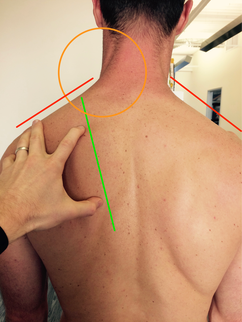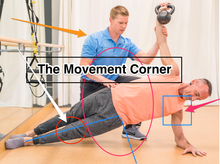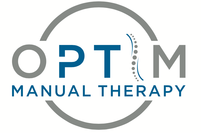 Scapular Depression Syndrome with associated Scapular Downward Rotation Scapular Depression Syndrome with associated Scapular Downward Rotation I was recently treating a patient who presented with left shoulder pain, weakness, and the sensation of instability following a surfing accident. The patient denied any history of dislocations, but reported the shoulder felt weak 'as if it could pop out' in various overhead positions. Due to the traumatic onset of symptoms, I suspected a partial labral tear or rotator cuff involvement as the underlying pathoanatomical problem. Regardless, it is not my job to fix the anatomical issues. As the physical therapist, it is my job to treat his underlying impairments and provide education on pain and proper movement. At his initial evaluation, he had both static and dynamic postural deficits. Statically, he was resting in scapular depression and downward rotation (see picture to the left). Dynamically, he had limited overhead mobility (see video below) as well as weakness in his serratus anterior and upper trapezius muscle. Additionally, he had decreased cervical rotation range of motion due to the depressed position of his scapula. A 'scapular assistance test,' which provides support to the shoulder girdle, revealed full, painfree cervical range of motion.
As part of his plan of care, treatment focused on retraining the upper trapezius muscle. Prior to starting therapy, his upper trapezius was placed in a chronically lengthened position due to his resting scapular posture. When reaching overhead, the upper trapezius muscle would activate early in the range of motion, and it could not complete its role as an upward rotator. The glenohumeral joint was placed on extra stress because the scapular stabilizers were not working synergistically. These deficits resulted in a sense of instability when reaching overhead. Strengthening or retraining the upper trapezius is typically important in individuals with a scapular depression. Identifying the movement dysfunction and addressing the proper impairments can prevent a patient from having surgery or prolonged pain. Jim Heafner PT, DPT, OCS  Want to learn more about dysfunctional movement? Check out OPTIM's Movement Corner, which focuses on deconstructing how and why we move! Sign-up before 12/14/16 and receive a complimentary copy of Dr. Heafner's Ebook, The Guide to Efficient Physical Theray Examination ($42 value).  OPTIM's COMT program is designed for the individual seeking to become an expert clinician. In our program, we provide a residency-type learning environment. Students will be exposed to quizzes, assignments, readings, lectures, and weekend labs. You will receive a residency level education and 75+ weekend lab hours. At the end of the program, you will be qualified to sit for the COMT examination as well as test into a fellowship program if you choose.
3 Comments
George
4/3/2020 11:00:54 am
How would you recommend strengthening the upper traps? Shrugs don't work for me - I've used wall slides, but do you have any suggestions please? Thank you
Reply
I look at it in terms of the orthopedic doctor being the "instructor" -and the patient the "student".
Reply
2/21/2023 02:43:03 am
Arthroscopic knee surgery is a minimally invasive procedure used to treat a variety of knee problems. The knee joint is made up of bone, soft tissue and cartilage, and each can cause problems. Traditionally, knee surgeries are performed as open tracks that have large incisions, pain…
Reply
Leave a Reply. |
Details
ContactEmail Good readsCategories |
 RSS Feed
RSS Feed